2018 MERCEDES-BENZ C-CLASS ESTATE trailer
[x] Cancel search: trailerPage 14 of 609
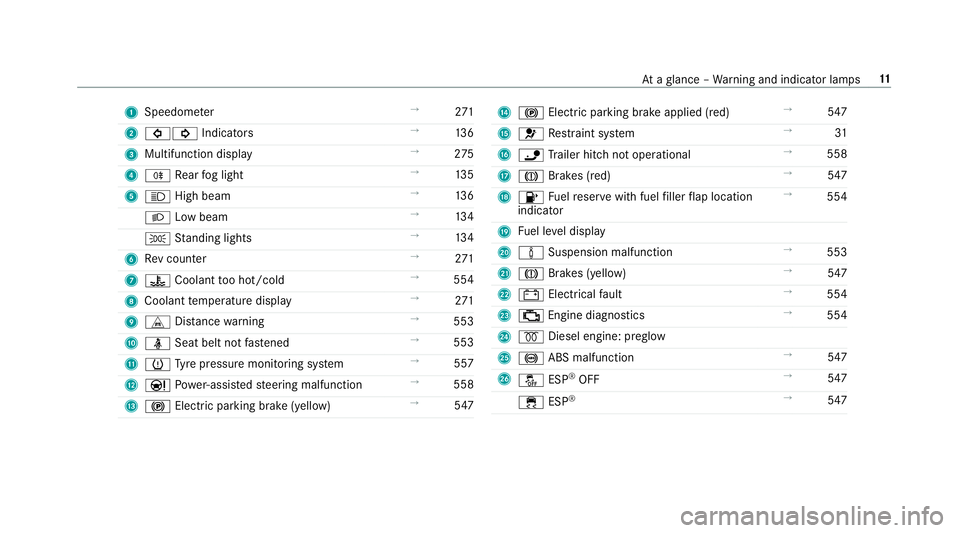
1
Speedom eter →
271
2 003E003D Indicators →
13 6
3 Multifunction display →
275
4 005E Rear fog light →
13 5
5 0057 High beam →
13 6
0058 Low beam →
13 4
0060 Standing lights →
13 4
6 Rev counter →
271
7 00AC Coolant too hot/cold →
554
8 Coolant temp erature display →
271
9 L Distance warning →
553
A 00E9 Seat belt not fastened →
553
B 0077 Tyre pressure monitoring sy stem →
557
C 00CC Powe r-assis tedsteering malfunction →
558
D 0024 Electric pa rking brake (yellow) →
547 E
0024 Electric pa rking brake applied (red) →
547
F 0075 Restra int sy stem →
31
G 00CA Trailer hit chnot operational →
558
H 004D Brakes (red) →
547
I 00B6 Fuelreser vewith fuel filler flap location
indicator →
554
J Fuel le vel display
K 00CC Suspension malfunction →
553
L 004D Brakes (yellow) →
547
M 003D Electrical fault →
554
N 00B9 Engine diagnostics →
554
O 0028 Diesel engine: preglow
P 0025 ABS malfunction →
547
Q 00BB ESP®
OFF →
547
00E5 ESP®
→
547 At
aglance – Warning and indicator lamps 11
Page 48 of 609
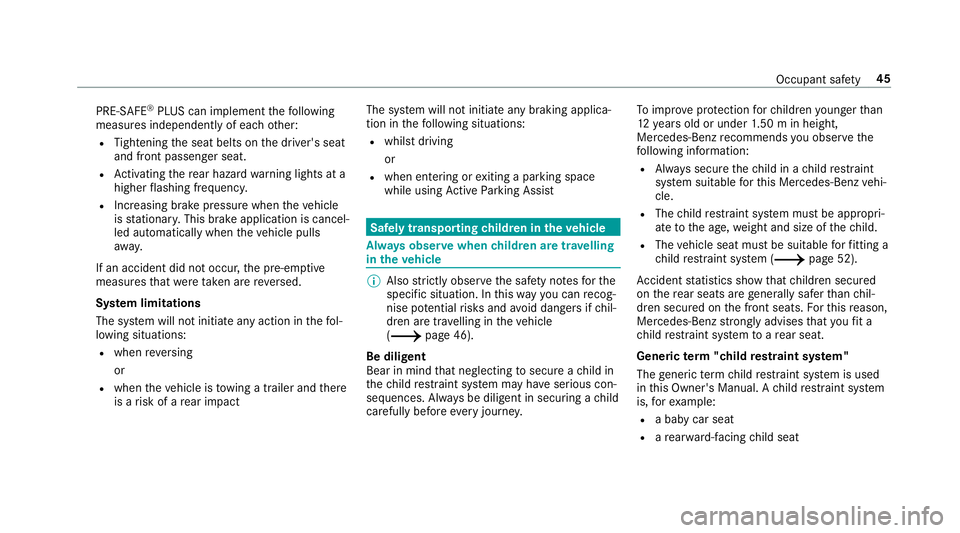
PRE-SAFE
®
PLUS can implement thefo llowing
measures independently of each other:
R Tightening the seat belts on the driver's seat
and front passenger seat.
R Activating there ar hazard warning lights at a
higher flashing frequenc y.
R Increasing brake pressure when theve hicle
is stationar y.This brake application is cancel‐
led automatically when theve hicle pulls
aw ay.
If an accident did not occur, the pre-em ptive
measures that we retake n are reve rsed.
Sy stem limitations
The sy stem will not initiate any action in thefo l‐
lowing situations:
R when reve rsing
or
R when theve hicle is towing a trailer and there
is a risk of a rear impact The sy
stem will not initiate any braking applica‐
tion in thefo llowing situations:
R whilst driving
or
R when entering or exiting a parking space
while using Active Parking Assist Safely transporting
children in theve hicle Alw
ays obser vewhen children are tr avelling
in theve hicle 0009
Also strictly obser vethe saf ety no tesfo rthe
specific situation. In this wa yyo u can recog‐
nise po tential risks and avoid dangers if chil‐
dren are tr avelling in theve hicle
(0013 page 46).
Be diligent
Bear in mind that neglecting tosecure a child in
th ech ild restra int sy stem may ha veserious con‐
sequences. Alw ays be diligent in securing a child
carefully before every journe y. To
impr ove pr otection forch ildren younger than
12 years old or under 1.50 m in height,
Mercedes-Benz recommends you obse rvethe
fo llowing information:
R Alw ays secure thech ild in a child restra int
sy stem suitable forth is Mercedes-Benz vehi‐
cle.
R The child restra int sy stem must be appropri‐
ate tothe age, weight and size of thech ild.
R The vehicle seat must be suitable forfitting a
ch ild restra int sy stem (0013 page 52).
Ac cident statistics show that children secured
on there ar seats are generally sa ferth an chil‐
dren secured on the front seats. Forth is reason,
Mercedes-Benz stronglyadvises that youfit a
ch ild restra int sy stem toare ar seat.
Generic term"child restra int sy stem"
The generic term child restra int sy stem is used
in this Owner's Manual. A child restra int sy stem
is, forex ample:
R a baby car seat
R are ar wa rd-facing child seat Occupant saf
ety45
Page 87 of 609
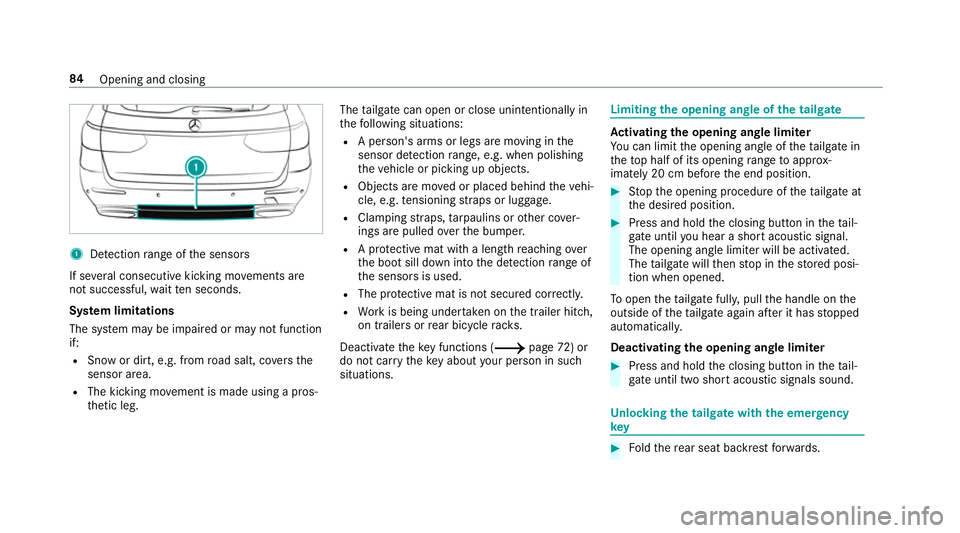
1
Detection range of the sensors
If se veral consecutive kicking mo vements are
not successful, waitte n seconds.
Sy stem limitations
The sy stem may be impaired or may not function
if:
R Snow or dirt, e.g. from road salt, co vers the
sensor area.
R The kicking mo vement is made using a pros‐
th etic leg. The
tailgate can open or close unin tentional lyin
th efo llowing situations:
R A person's arms or legs are moving in the
sensor de tection range, e.g. when polishing
th eve hicle or picking up objects.
R Objects are mo ved or placed behind theve hi‐
cle, e.g. tensioning stra ps or luggage.
R Clamping stra ps, tarp aulins or other co ver‐
ings are pulled overth e bumper.
R A pr otective mat with a length reaching over
th e boot sill down into the de tection range of
th e sensors is used.
R The pr otective mat is not secured cor rectl y.
R Workis being under take n on the trailer hitch,
on trailers or rear bicycle rack s.
Deactivate theke y functions ( 0013page72) or
do not ca rryth eke y about your person in such
situations. Limiting
the opening angle of the tailgate Ac
tivating the opening angle limiter
Yo u can limit the opening angle of theta ilgate in
th eto p half of its opening range toappr ox‐
imately 20 cm before the end position. 0007
Stop the opening procedure of theta ilgate at
th e desired position. 0007
Press and hold the closing button in theta il‐
ga te until you hear a sho rtacoustic signal.
The opening angle limiter will be activated.
The tailgate will then stop in thestored posi‐
tion when opened.
To open theta ilgate full y,pull the handle on the
outside of theta ilgate again af ter it has stopped
automaticall y.
Deactivating the opening angle limiter 0007
Press and hold the closing button in theta il‐
ga te until two sho rtacoustic signals sound. Un
locking the tailgate with the emer gency
key 0007
Foldthere ar seat backrest forw ards. 84
Opening and closing
Page 151 of 609
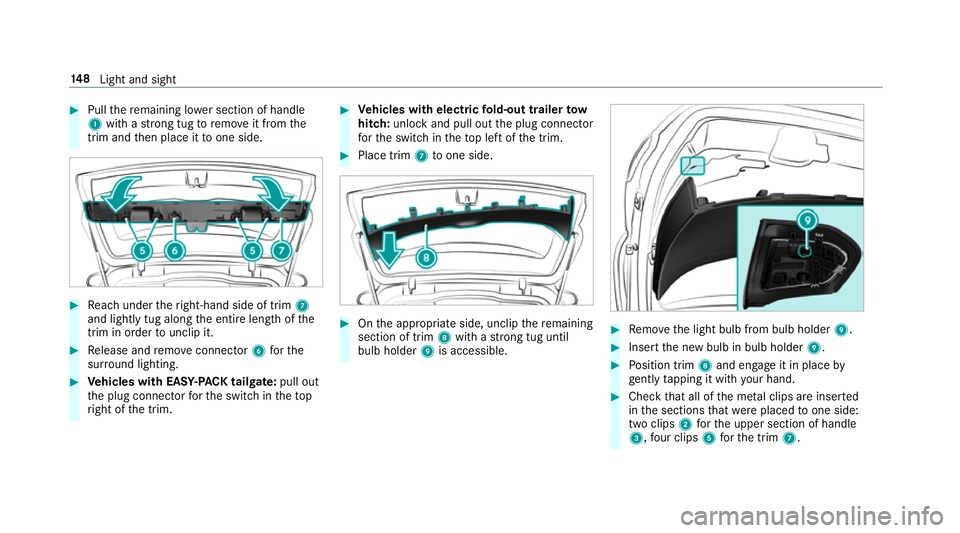
0007
Pull there maining lo wer section of handle
1 with a strong tug toremo veit from the
trim and then place it toone side. 0007
Reach under theright-hand side of trim 7
and lightly tug along the entire length of the
trim in order tounclip it. 0007
Release and remo veconnector 6forthe
sur round lighting. 0007
Vehicles with EASY -PAC K tailgate: pull out
th e plug connector forth e switch in thetop
ri ght of the trim. 0007
Vehicles with electric fold-out trailer tow
hit ch: unlo ckand pull out the plug connector
fo rth e switch in theto p left of the trim. 0007
Place trim 7toone side. 0007
Onthe appropriate side, unclip there maining
section of trim 8with a strong tug until
bulb holder 9is accessible. 0007
Remo vethe light bulb from bulb holder 9. 0007
Insert the new bulb in bulb holder 9. 0007
Position trim 8and engage it in place by
ge ntly tapping it with your hand. 0007
Check that all of the me tal clips are inse rted
in the sections that we replaced toone side:
two clips 2forth e upper section of handle
3, four clips 5forth e trim 7. 14 8
Light and sight
Page 152 of 609
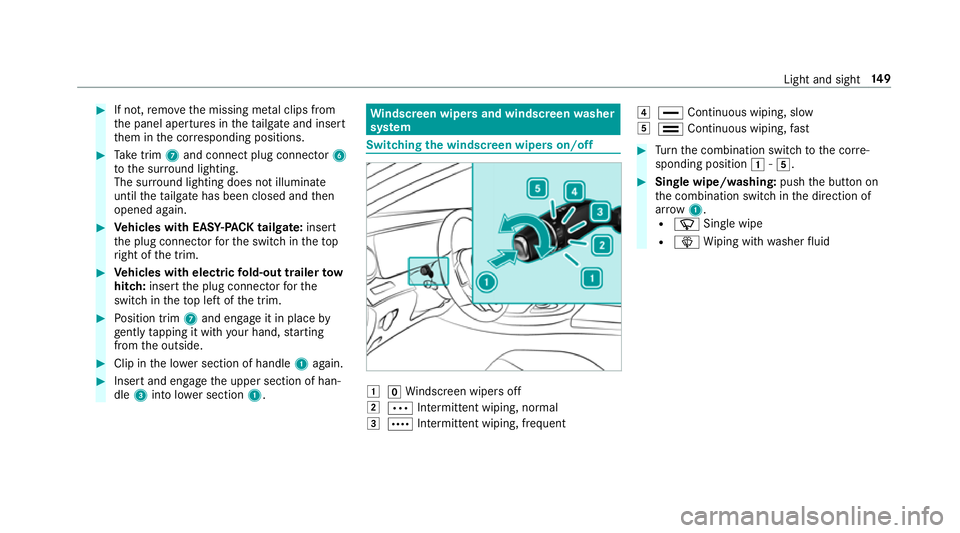
0007
If not, remo vethe missing me tal clips from
th e panel apertures in theta ilgate and inse rt
th em in the cor responding positions. 0007
Take trim 7and connect plug connector 6
to the sur round lighting.
The sur round lighting does not illuminate
until theta ilgate has been closed and then
opened again. 0007
Vehicles with EASY -PAC K tailgate: insert
th e plug connector forth e switch in thetop
ri ght of the trim. 0007
Vehicles with electric fold-out trailer tow
hit ch: inse rtthe plug connector forthe
switch in theto p left of the trim. 0007
Position trim 7and engage it in place by
ge ntly tapping it with your hand, starting
from the outside. 0007
Clip in the lo wer section of handle 1again. 0007
Insert and engage the upper section of han‐
dle 3into lo wer section 1. Wi
ndscreen wipers and windscreen washer
sy stem Switching
the windscreen wipers on/off 0047
005AWindsc reen wipers off
0048 0062 Intermittent wiping, normal
0049 0063 Intermittent wiping, frequent 004A
00AA Continuous wiping, slow
004B 00A9 Continuous wiping, fast 0007
Turn the combination switch tothe cor re‐
sponding position 0047-004B. 0007
Single wipe/washing: pushthe button on
th e combination switch in the direction of
ar row 1.
R 00D3 Single wipe
R 00D4 Wiping with washer fluid Light and sight
14 9
Page 190 of 609
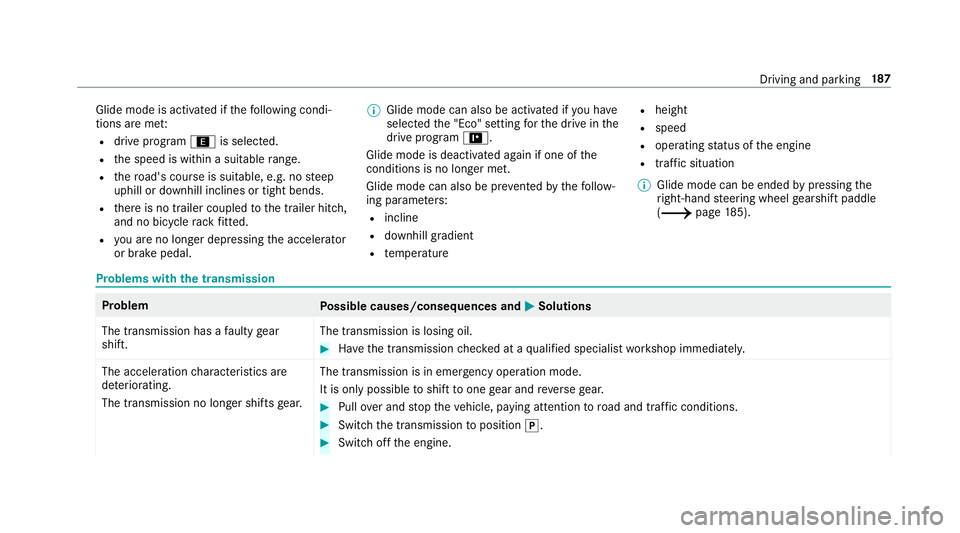
Glide mode is activated if
thefo llowing condi‐
tions are me t:
R drive program ;is selected.
R the speed is within a suitable range.
R thero ad's course is suitable, e.g. no steep
uphill or downhill inclines or tight bends.
R there is no trailer coupled tothe trailer hitch,
and no bicycle rack fitted.
R you are no lon ger depressing the accelera tor
or brake pedal. 0009
Glide mode can also be activated if you ha ve
selected the "Eco" setting forth e drive in the
drive prog ram =.
Glide mode is deactivated again if one of the
conditions is no longer met.
Glide mode can also be pr evented bythefo llow‐
ing parame ters:
R incline
R downhill gradient
R temp erature R
height
R speed
R operating status of the engine
R traffic situation
0009 Glide mode can be ended bypressing the
ri ght-hand steering wheel gearshift paddle
(0013 page185). Problems with th
e transmission Problem
Possible causes/consequences and 0050
0050Solutions
The transmission has a faulty gear
shift. The transmission is losing oil. 0007
Have the transmission checked at a qualified specialist workshop immediatel y.
The acceleration characteristics are
de teriorating.
The transmission no longer shifts gear. The transmission is in emer
gency operation mode.
It is only possible toshift toone gear and reve rsege ar. 0007
Pull over and stop theve hicle, paying attention toroad and traf fic conditions. 0007
Switch the transmission toposition 005D. 0007
Switch off the engine. Driving and parking
187
Page 209 of 609
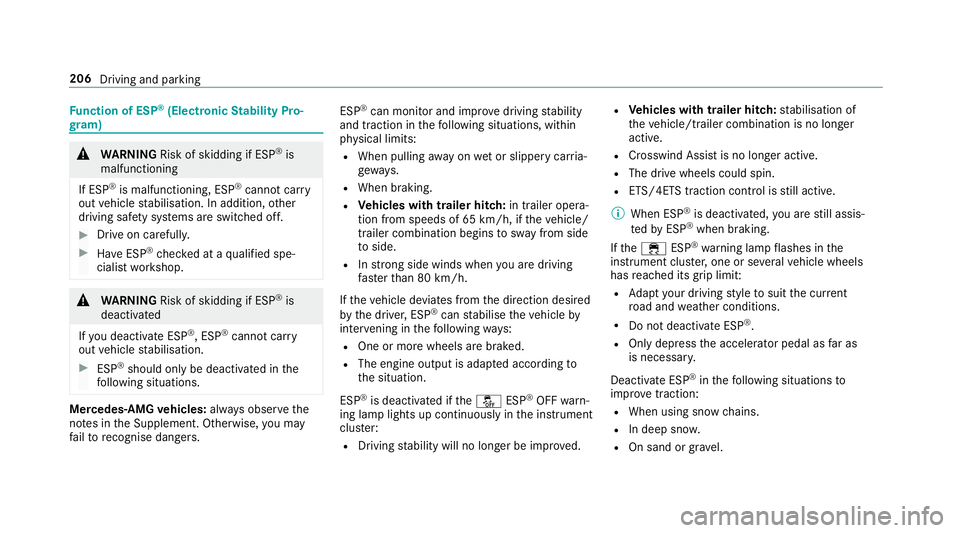
Fu
nction of ESP ®
(Electronic Stability Pro‐
gr am) 000A
WARNING Risk of skidding if ESP ®
is
malfunctioning
If ESP ®
is malfunctioning, ESP ®
cannot car ry
out vehicle stabilisation. In addition, other
driving saf ety sy stems are switched off. 0007
Drive on carefull y.0007
Have ESP ®
ch ecked at a qualified spe‐
cialist workshop. 000A
WARNING Risk of skidding if ESP ®
is
deactivated
If yo u deactivate ESP ®
, ESP ®
cannot car ry
out vehicle stabilisation. 0007
ESP ®
should on lybe deactivated in the
fo llowing situations. Mercedes‑AMG
vehicles: always obser vethe
no tes in the Supplement. Otherwise, you may
fa ilto recognise dangers. ESP
®
can moni tor and impr ovedriving stability
and traction in thefo llowing situations, within
ph ysical limits:
R When pulling away on wet or slippe rycar ria‐
ge wa ys.
R When braking.
R Vehicles with trailer hitch: in trailer opera‐
tion from speeds of 65 km/h, if theve hicle/
trailer combination begins tosw ay from side
to side.
R Instro ng side winds when you are driving
fa ster than 80 km/h.
If th eve hicle deviates from the direction desired
by the driver, ESP ®
can stabilise theve hicle by
inter vening in thefo llowing ways:
R One or more wheels are braked.
R The engine output is adap ted according to
th e situation.
ESP ®
is deactivated if the00BB ESP®
OFF warn‐
ing lamp lights up continuously in the instrument
clus ter:
R Driving stability will no lon ger be impr oved. R
Vehicles with trailer hitch: stabilisation of
th eve hicle/trailer combination is no longer
active.
R Crosswind Assist is no longer active.
R The drive wheels could spin.
R ETS/4ETS traction control is still active.
0009 When ESP ®
is deactivated, you are still assis‐
te dby ESP ®
when braking.
If th e00E5 ESP®
wa rning lamp flashes in the
instrument clus ter,one or se veralve hicle wheels
has reached its grip limit:
R Adapt your driving style to suit the cur rent
ro ad and weather conditions.
R Do not deactivate ESP ®
.
R Onlydepress the accelera tor pedal as far as
is necessar y.
Deactivate ESP ®
in thefo llowing situations to
impr ove traction:
R When using snow chains.
R In deep sn ow.
R On sand or gr avel. 206
Driving and parking
Page 212 of 609
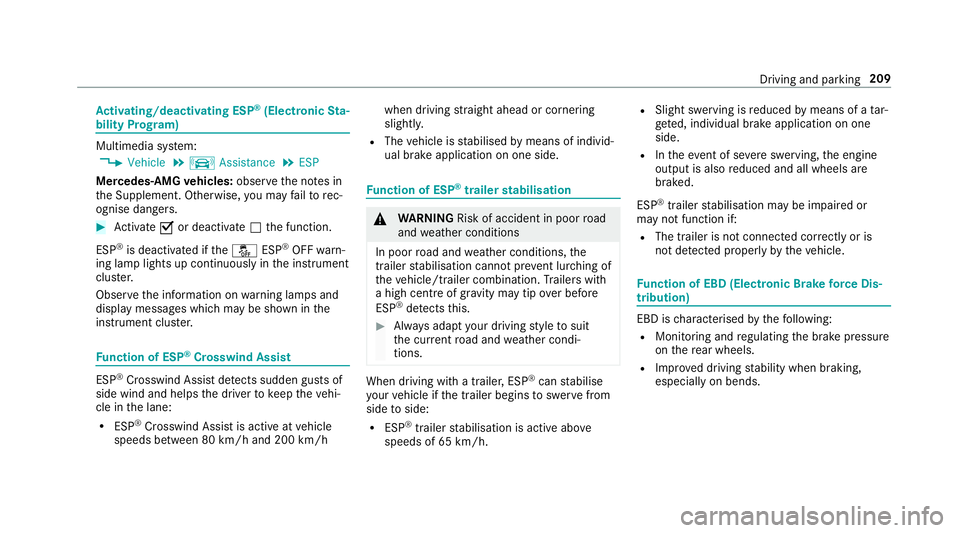
Ac
tivating/deactivating ESP ®
(Electronic Sta‐
bility Prog ram) Multimedia sy
stem:
0018 Vehicle 0019
k Assistance 0019
ESP
Mercedes‑AMG vehicles: observeth e no tes in
th e Supplement. Otherwise, you may failto rec‐
ognise dangers. 0007
Activate 0073or deacti vate 0053 the function.
ESP ®
is deactivated if the00BB ESP®
OFF warn‐
ing lamp lights up continuously in the instrument
clus ter.
Obser vethe information on warning lamps and
display messages which may be shown in the
instrument clus ter. Fu
nction of ESP ®
Crosswind Assist ESP
®
Crosswind Assist de tects sudden gu sts of
side wind and helps the driver tokeep theve hi‐
cle in the lane:
R ESP ®
Crosswind Assist is active at vehicle
speeds between 80 km/h and 200 km/h when driving
stra ight ahead or cornering
slight ly.
R The vehicle is stabilised bymeans of individ‐
ual brake application on one side. Fu
nction of ESP ®
trailer stabilisation 000A
WARNING Risk of accident in poor road
and weather conditions
In poor road and weather conditions, the
trailer stabilisation cannot pr event lur ching of
th eve hicle/trailer combination. Trailers with
a high centre of grav ity may tip over before
ESP ®
de tects this. 0007
Alw ays adapt your driving style to suit
th e cur rent road and weather condi‐
tions. When driving with a trailer, ESP
®
can stabilise
yo ur vehicle if the trailer begins toswer vefrom
side toside:
R ESP ®
trailer stabilisation is active abo ve
speeds of 65 km/h. R
Slight swerving is reduced bymeans of a tar‐
ge ted, individual brake application on one
side.
R Intheeve nt of se vere swerving, the engine
output is also reduced and all wheels are
braked.
ESP ®
trailer stabilisation may be impaired or
may not function if:
R The trailer is not connec ted cor rectly or is
not de tected prope rly by theve hicle. Fu
nction of EBD (Electronic Brake forc e Dis‐
tribution) EBD is
characterised bythefo llowing:
R Monitoring and regulating the brake pressure
on there ar wheels.
R Impr oved driving stability when braking,
especially on bends. Driving and parking
209